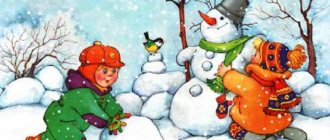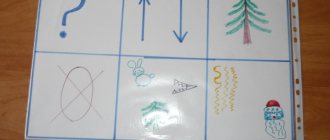Junior group
For younger preschoolers, simple educational, active and musical games are recommended.
Post a flower
Make two paper daisies for the game with the petals separated from the core. The number of petals must correspond to the number of players. Place daisies on the floor near the wall. Divide the students into 2 groups with an equal number of players.
Invite teams to move their daisy to the opposite wall. Each player transfers only one part of the plant: the first - the yellow core, the second - the petal, and so on. A player is not allowed to take two petals at once. The next participant starts moving when the previous one returns to the start. The team that collects its daisy first wins.
Collect a bouquet
Before playing, tell the children what parts flowers are made of: core, petals, stems and leaves. Cut out plant parts from colored paper and glue them into a bouquet arrangement, but do not glue the petals. Make petals of a certain color from the main spectrum for each flower. Tell the students that the wind tore off the petals, which now need to be selected according to the color for each plant in the bouquet.
You can also offer students a similar didactic game “Collect a flower.”
Bells
Children choose a leader by lot. He leaves the room. The players hide a picture depicting a blooming bell in the game room, disassemble the musical instruments themselves - small bells, and distribute them throughout the room. Moreover, one of the players must stand close to the hidden image.
The presenter enters the playroom, begins to walk around it, and approaches the children. When he approaches a player who is standing far from the picture, he does not ring the bell. When he approaches a participant standing closer to the picture, he makes a quiet ringing sound. The leader approaches the target even closer - the player makes a louder sound. The participant closest to the others rings the loudest. This way the presenter understands where to go in searching for the picture.
A flower is blooming
The game is educational. First tell the children how flowers bloom in nature. Prepare plant templates and distribute to students. Show how to curl the petals. Let the children put the flowers in a glass of water and observe what happens to the petals. When exposed to moisture, the petals will begin to “bloom.”
Middle group
Older preschoolers should know where flowers grow, what features and properties different types of plants have. It is important to instill in students a love for the nature of their native land. We must not forget about the physical activity of the children.
Where does the flower grow
For the game, prepare pictures of flower beds, fields, forests. Make cards depicting flowers familiar to the children. Invite the players to distribute the cards according to the pictures of growing places.
Flower drawing competition
By participating in an art competition, children develop imagination, creative skills, and color perception.
For the competition, purchase or pick a large flower from your garden: tulip, peony, rose, sunflower, iris or other. Children prepare art supplies and sit at easels, if available, or tables. From the finished works they put together an exhibition and choose the winner of the competition whose work they liked the most.
Flowers
The didactic game “Flowers” develops speech skills, imaginative thinking, and the ability to select descriptive features.
Ask a question and let the children give descriptions. You cannot repeat yourself; for each correct answer the player receives a point. The participant with the most points wins.
Here are sample questions:
- What kind of rose? – beautiful, red, lush, fragrant, tender;
- What flowers have spines? – rose, rose hip, cactus, blackthorn, burdock;
- What flowers are perfume made from? – jasmine, lavender, rose, lily of the valley, peony;
- What plants are honey made from? – dandelion, linden, acacia, clover;
- What flowers are yellow? – sunflower, dandelion, narcissus, buttercup.
Flower catch-up
Each player chooses the name of the flower; they should not be repeated. The players decide by lot who is catching up. Let it be “Cornflower”. He names some other plant, for example, “Dandelion”. The player who chose the name “Dandelion” runs away. "Cornflower" catches up with him. When “Dandelion” feels like it is about to be overtaken, it may say out loud another flower, such as “Chamomile.” Then “Romashka” has to run away, “Cornflower” switches to her. If “Dandelion” does not have time to pronounce the word and is caught, then it becomes catching up.
Didactic games on flowers
Didactic ball game “Flower names”
Target:
- introduce people’s names that come from the names of plants (Rose, Lily, Narcissus, Cornflower (affectionate from Vasya), Anyuta, Roma (chamomile), Violetta, Veronica, Valerian; pink, lilac, lemon);
- learn to guess the derivative name of a flower from the named object (bell - bell, the eyes of the girl Anya - Pansy, nail - carnation, jug - water lily);
- develop dexterity when throwing a ball, reaction speed, speed of thinking, memory;
— cultivate the ability to be attentive when interacting with the teacher.
* * *
Children stand in a circle, the teacher stands in the middle of the circle with a ball. The teacher throws the ball to the children one by one and gives tasks (name a person’s name that comes from the name of a flower; identify objects whose names come from the name of flowers). The child must catch the ball and quickly answer the question. If he does not answer or answers incorrectly, another child receives the ball with the same task.
Didactic game “Bouquet of Flowers”
Target:
- to form an idea of the rules for making bouquets, about in what cases people give each other bouquets;
- the ability to compose a bouquet of flowers from ready-made forms, selecting them according to size, color, shades, purpose, desire (applique or drawing);
- talk about your bouquet (what plants it is made of, how the flowers were selected, who you would like to give such a bouquet to, for what occasion);
- develop imagination, spatial, color perception, sense of taste, measures, speech, fine motor skills of the hands;
- cultivate love and active interest in native nature.
* * *
In the game, children play the roles of a florist or flower shop seller. Children can do the work of making a bouquet individually or collectively, in small subgroups, solving the problem of developing the ability to negotiate and determine the sequence of work. Children can make a bouquet of any flowers: live, artificial, or made by children from paper, fabric, foam rubber, dough, vegetables, etc.
To warm up, you can use the “Flower” finger exercises.
Children, as flower shop sellers, must “sell” the collected bouquet by describing it, telling what flowers it consists of, why, and what it is intended for.
The teacher acts as a florist consultant, directing the children’s activities and helping with advice.
Ball game "I know five colors"
Target:
— consolidate knowledge about meadow and garden flowers;
- develop the ability to hit and catch the ball, rhythmically pronouncing the names of colors without losing the tempo;
— interest in using knowledge about colors in games with peers;
- combine a noun with a numeral;
- develop dexterity, speed of reaction, speed of thinking.
* * *
Child (hits the ball on the ground and says). I know five names of meadow flowers: chamomile - one, bell - two, carnation - three, etc.
If a child gets confused or pauses too long, he loses and the ball is passed to another child.
Didactic game “Labor in the flower garden”
Target:
- to form an idea of how flowers are grown depending on the timing of flowering and whether they are annual or perennial;
— interest in knowledge that helps to increase natural resources;
— learn to lay out cards with a schematic representation of the planting sequence in order, explain the order and significance of each stage;
- activate in the dictionary the names of planting material (seeds, bulbs, tubers), actions (sow, plant, dig, loosen, mark, water, fertilize, break a flower bed, weed, replant, plant, divide a bush, prune);
— develop the ability to build a chain of events in a logical sequence, memory, and vocabulary.
* * *
Children-gardeners choose pictures with planting material and images of flowers, each in his flower garden lays out the sequence of planting and caring for the selected flowers, talks about what flower beds he will create, how to place the plants, how to care for them throughout the entire period of their growth and flowering. For the most detailed and correct stories, gardeners are awarded the “Flower Experts” medal.
Didactic exercise “Collect flower petals from shades”
Target:
— to develop knowledge about the most famous flowers in the area, the petals of which are colored in different shades;
- learn to assemble flower petals (for example, pansies) from individual elements, colored from the lightest to the darkest shade of the same color;
- name shades and colors;
- develop aesthetic taste, sense of color, spatial perception;
- create a sense of beauty.
Equipment:
individual elements of flower petals, painted in different shades of the same color, having different shapes.
* * *
The teacher invites the children to lay out a certain flower from parts of the petals, painted in different shades from the lightest to the darkest, and name them; decorate the panel with flowers.
Didactic exercise “The fourth odd one”
Target:
- to develop the ability to classify flowers according to their place of growth (meadow, field, forest, garden, aquatic), according to the timing of flowering (spring, summer, autumn);
- name the extra flower in the row, designate the rest with a general word, explain the grouping;
- develop logical thinking and speech;
- perseverance, focus.
Equipment:
cards depicting five colors, four of which can be combined, and the fifth is extra.
The teacher remembers with the children what flowers grow and bloom in the summer in the garden, field, forest, meadow, clearings, and pond. Looks at pictures depicting different ecosystems in the summer. Offers children cards with four flowers, three of which can be attributed to a specific type (meadow, field, forest, garden or aquatic), and the fourth is extra. Children must name all the flowers, find the extra one, explain why, and name the rest with one general word. Cards are selected in accordance with the age of the children and the material studied.
Senior group
Games for older preschoolers should be aimed at developing logical thinking, speech, intelligence, curiosity, and perseverance. At this age, children must classify plants according to different characteristics, and preparation for school begins.
Turning into a flower
The game strengthens the facial muscles and promotes overall physical development.
Invite the students to use facial expressions and body movements to depict a flower, how it opens its petals, reaches out to the sunlight, bends its stem under the raindrops, and closes for the night.
Name the odd one out
For the game, prepare groups of cards: meadow species, forest, field, garden, water. There are 4 plants in each group, one of them does not correspond to the category. Lay out the cards in front of the players, ask them to name the extra type and explain their opinion.
For example: rose, tulip, clover, peony. Clover is not a garden plant, but a meadow plant.
Flowers
In addition to getting to know plants, the goal of the didactic game “Flowers” is physical training, developing dexterity and a sense of rhythm.
The children take turns playing. The player takes the ball, hits it on the floor or wall, catches it, and names a plant with each hit. He must name 5 species. You can't repeat yourself. If a player cannot remember the plant, then he gives the ball and the right to play to the next player.
Name the adjective
The game develops the skill of forming adjectives from nouns. Name the flower and the object. The player must name an adjective that is a qualitative attribute of this object:
- poppy, and the grain... poppy;
- chamomile, and the field... chamomile;
- a rose, and the bud... pink;
- acacia, and honey... acacia;
- cornflower, and the eyes... cornflower blue;
- dandelion, and the jam... dandelion.
Didactic games “Plants” in the senior group
We offer games for older preschoolers that expand and clarify knowledge about wild and indoor plants, their characteristics and places of growth.
Medicinal plants
The game reinforces ideas about the medicinal purposes of plants. The lesson requires pictures of medicinal herbs and shrubs known to preschoolers.
The teacher shows pictures one by one, and the children tell everything they know about the plant depicted: where it grows, what benefits it brings, what parts of it are used for medicinal purposes.
Didactic games “Indoor plants”
There are several games using indoor flowers. For classes, you need to choose potted plants that differ significantly in appearance and are familiar to preschoolers.
Game options:
- The teacher arranges flower pots in a row. First, he asks to name the plants in their order. For example, the second on the right side or the fifth on the left. Then the children perform the reverse task. The teacher asks, for example: “Where is the ficus?” The children answer: “He is third on the left side.”
- The teacher asks to name plants with certain characteristics. For example, with long hanging stems or with variegated leaves.
- Children look at the leaves of potted flowers. They share what they think the leaves of each plant look like.
- The teacher places 4–6 plants in a row. The students try to remember them, then close their eyes. The teacher removes one flower. Children, opening their eyes, try to remember which plant is missing. The game can be complicated by adding new plants to the row.
Ripe or not ripe
The game teaches you to visually determine the ripeness of fruits. The teacher lays out vegetables, berries, and fruits of varying degrees of ripening in front of the children. On command, children choose the ripest fruits among the fruits. At the second stage, they try to identify fruits of medium maturity.
The game can be active. The children are divided into two groups: the first receive ripe fruits, the second receive the same fruit, only unripe. Children dance and run to the accompaniment of music. And when the signal sounds, they try to find a friend with a similar fruit, only of a different degree of maturity.
Hang the fruit on the branch
Preschoolers are divided into two groups: the first receive branches of vegetable and tree crops, the second receive the corresponding fruits. On command, the children look for a pair, that is, they try to attach the fruit to a branch.
What types of flowers are there?
First, the teacher tells the students that there are garden, potted, forest, field, and meadow flowers. They differ in size, foliage, and inflorescences.
For the game you need images of flowers growing in different conditions. The game task is to divide the pictures into groups according to their location: forest, meadow, field, garden, house. During the differentiation process, players compare the external characteristics of plants and describe each species in detail.
Preparatory group
At this age, kindergarteners are preparing for school. They must have narration skills, tell from memory and visual material. It is important, with the help of games, to develop imagination, memory, spatial and color perception in future schoolchildren, to cultivate communication skills, a sense of beauty, the ability to build a dialogue, attentiveness, and perseverance.
What kind of flower are you?
Invite the students to “turn” into flowers. Each player chooses what kind of plant to become, but does not tell his comrades about it. Children take turns coming forward, depicting their flower using facial expressions and body movements, without uttering a word. The rest of the guys must guess what plant we are talking about.
Flower shop
For the game, prepare natural or artificial flowers. Children act as florists. The game is collective and teaches communication, teamwork, and organization.
The students make up a beautiful bouquet. Then they try to sell it to the teacher. At the same time, they must praise the bouquet, explain what plants were used, why they chose them, and for what purpose the flower arrangement is intended.
Flower names
The players form a circle. The teacher stands in the center, throws the ball to each child in turn, saying a name or an object named similar to a flower. The player who catches the ball must name the corresponding plant. For example: Vasily - cornflower, nail - carnation, Roman - chamomile, jug - water lily, Lilya - lily, Violetta - viola, toffee - iris. The player who finds it difficult to answer is eliminated from the circle.





